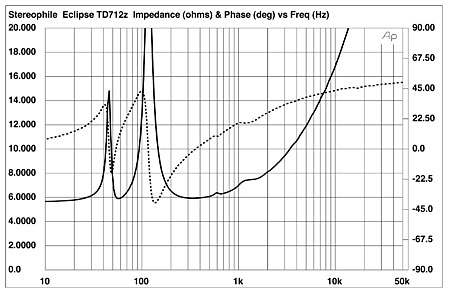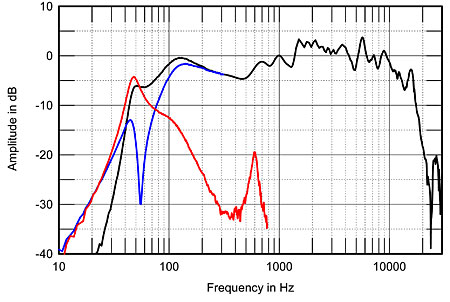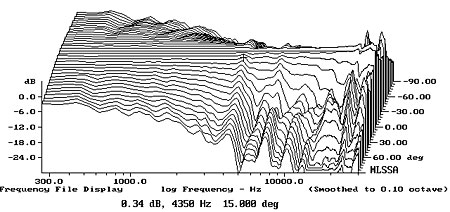| Columns Retired Columns & Blogs |
Fujitsu Ten Eclipse TD712z loudspeaker Measurements
Sidebar 3: Measurements
The Eclipse TD712z's voltage sensitivity was to specification but significantly lower than average, at an estimated 83.5dB(B)/2.83V/m. However, its impedance remains above 6 ohms at almost all frequencies (fig.1), and rises in value above the midrange, this due, I assume, to the effect of the single drive-unit's voice-coil inductance. This speaker will be easy to drive, even by low-powered tube amplifiers.

Fig.1 Eclipse TD712z, electrical impedance (solid) and phase (dashed). (2 ohms/vertical div.)
The traces in fig.1 feature a couple of small discontinuities in the upper midrange, but the loudspeaker's beautifully finished, egg-shaped enclosure was effectively free from vibrational resonances. All that an accelerometer revealed was a very slight degree of movement at 130Hz (fig.2), and nothing at all above the graph's –30dB noise floor at higher frequencies. However, the nearfield response of the rear-facing reflex port (fig.3, red trace) features a fairly low-level resonance at 700Hz, this the frequency of one of the discontinuities in the impedance traces. It is possible that because the port faces away from the listener, this, in combination with the low level of the mode, will minimize its audibility.

Fig.2 Eclipse TD712z, cumulative spectral-decay plot calculated from the output of an accelerometer fastened to the top center of the cabinet (MLS driving voltage to speaker, 7.55V; measurement bandwidth, 2kHz).
The saddle centered on 55Hz in the impedance-magnitude trace indicates that this is the port's tuning frequency, which is confirmed by the fact that this is also the frequency of the minimum-motion notch of the drive-unit's nearfield response (fig.3, blue trace). However, the port's output peaks a little lower in frequency, meaning that it doesn't quite fully reinforce the drive-unit's output below the system resonance. As a consequence, the sum of the drive-unit and port outputs, taking into account acoustic phase and the distance between the two radiators (fig.3, black trace below 300Hz), shelves down a little before the usual 24dB/octave reflex rollout. As Robert Deutsch found, this speaker's balance is somewhat light in weight.

Fig.3 Eclipse TD712z, anechoic response on drive-unit axis at 50", averaged across 30° horizontal window and corrected for microphone response, with the nearfield responses of the single drive-unit (blue trace) and the port (red) plotted below 300Hz and 900Hz, respectively, and the complex sum of the nearfield responses plotted below 300Hz (black).
Higher in frequency, the upper-midrange and treble regions are shelved up by a couple of dB, which will make the speaker very revealing of recorded detail (as RD mentions in his auditioning notes) but perhaps a little unforgiving of problems with source and amplification components (which RD didn't find to be the case). Though the treble region is flat overall, there is a succession of small peaks and dips of approximately equal amplitude. As might be expected from a speaker with a single drive-unit, the frequency response rolls off quickly above 10kHz. RD does comment that the lack of top-octave extension actually better balances the TD712z's limited low-frequency output than would be the case with a conventional design.
The speaker's horizontal radiation pattern is shown in fig.4, plotted at 5° intervals, each trace normalized to the on-axis response. (The TD712z's symmetrical cabinet design means that the vertical pattern was basically identical.) The dispersion is superbly even below 4.35kHz, but there is a sharp discontinuity at that frequency, with a rapid rolloff to the speaker's sides. Usually, this kind of behavior would give a speaker a rather lifeless quality in the listening room, but the shelved-up treble output might well compensate for this, at least up to 10kHz.

Fig.4 Eclipse TD712z, lateral response family at 50", normalized to response on tweeter axis, from back to front: differences in response 90–5° off axis, reference response, differences in response 5–90° off axis.
The Eclipse TD712z's impulse response (fig.5) is typical of a design with a single drive-unit, with a sharp up/down spike of energy, though this is followed by some low-level ringing; this is probably associated with the small peaks seen in the frequency response's treble region. The step response (fig.6) has an excellent, time-coincident, right-triangle shape, though again, some lower-frequency ripples are evident. As a result, some ridges of delayed energy can be seen in the cumulative spectral-decay plot (fig.7), the most prominent lying at 1.2kHz (the frequency of the response step seen in fig.3) and 5.7kHz.

Fig.5 Eclipse TD712z, impulse response on drive-unit axis at 50" (5ms time window, 30kHz bandwidth).

Fig.6 Eclipse TD712z, step response on drive-unit axis at 50" (5ms time window, 30kHz bandwidth).

Fig.7 Eclipse TD712z, cumulative spectral-decay plot at 50" (0.15ms risetime).
Considering its unusual design, the Eclipse TD712z measured much better than I was expecting. As RD notes, this is not a speaker that will go very loud or very deep, and tonally it is not all that neutral. However, it does offer other benefits, particularly in its time-coincident presentation and freedom from cabinet resonances. And it looks stunning!—John Atkinson
- Log in or register to post comments




































